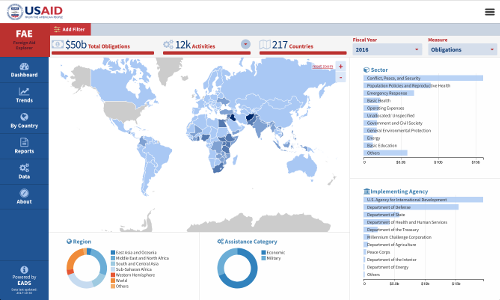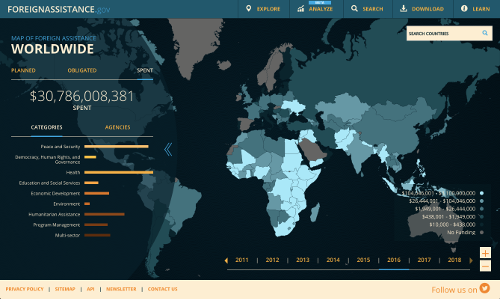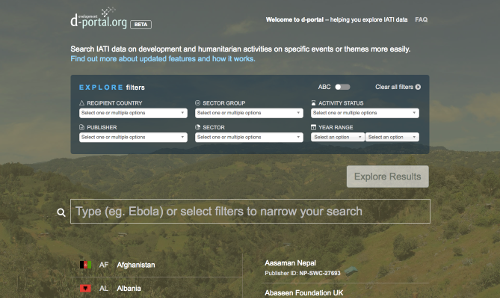US Data on Foreign Assistance: What to know and what to use
We have recently launched a new project which will combine open aid data with in-country research to assess the impact of potential changes to the US foreign assistance budget. Our first step has been to look into a range of sources of US foreign assistance data. There are a number of different platforms, so below we have listed some of the better known sources for this data, along with our thoughts on their pros and cons based on our recent experience of using them.
USAID’s Foreign Aid Explorer
 The Foreign Aid Explorer (FAE) is a useful source of data on how and where the US is disbursing its foreign assistance. Users can quickly see where funds are going as either obligations or disbursements, by country, by sector, and by implementing agency. The data goes back to 2001, which enables useful trend analyses. Users can browse the data using the interface, or simply enter a query and download it as a spreadsheet.
The Foreign Aid Explorer (FAE) is a useful source of data on how and where the US is disbursing its foreign assistance. Users can quickly see where funds are going as either obligations or disbursements, by country, by sector, and by implementing agency. The data goes back to 2001, which enables useful trend analyses. Users can browse the data using the interface, or simply enter a query and download it as a spreadsheet.
The data behind the FAE is collected because of two USAID mandates: to officially report 1) foreign assistance levels to the federal government via the US Greenbook, and 2) all US overseas development assistance to the OECD DAC. To carry out these responsibilities, USAID collects and then vets foreign assistance data from 30 agencies.
FAE data is, therefore, verified and reliable. As of now, the most current complete information available is from FY’16. Partial information (as noted on the site) is available for FY’17. As a whole, this is a very useful and easy to use platform.
Foreignassistance.gov
 ForeignAssistance.gov (FA.gov) was established in 2010 to serve as a one-stop source of all foreign assistance spending. It is also the official entity responsible for reporting US data to the International Aid Transparency Initiative (see below).
ForeignAssistance.gov (FA.gov) was established in 2010 to serve as a one-stop source of all foreign assistance spending. It is also the official entity responsible for reporting US data to the International Aid Transparency Initiative (see below).
FA.gov contains planned, obligated and disbursed figures up until FY’16, and partial figures for FY’17. Additionally, FA.gov contains US budgetary information, including the FY’18 request. Users can download all planned data: disaggregated by country and sector, as well as by fiscal year. We found this useful.
One of the problems with FA.gov, however, is that the information is often incomplete but the site gives no indication of this, making the data potentially misleading. This becomes more apparent when data between USAID Explorer and FA.gov report are compared. As part of our US budget work, we came across the following inconsistencies:
| Examples: FY 2016 | FA.gov | FAE |
| Total obligated | $28,317,081,957 | $49,816,978,550 |
| Total spent | $30,786,008,381 | $46,177,465,678 |
| Liberia, total spend | $335,520,827 | $438,073,086 |
| Department of State, Liberia, total spend | $59,210 | $10,677,049 |
| Cambodia, total spend | $85,575,705 | $107,488,385 |
| Department of State, Cambodia, total spend | 0 | $4,737,218 |
 The figures above are dramatically different for total spend and obligations for FY ‘16 – off by billions for the total figures. A cursory look at Liberia’s total spend, for example, also shows a difference of over $100,000,000 – a gap probably caused by FA.gov not including all active agencies. For example, FA.gov does not reference Millennium Challenge Corporation’s activities in Liberia which, according to the FAE, disbursed $60.3m in 2016.
The figures above are dramatically different for total spend and obligations for FY ‘16 – off by billions for the total figures. A cursory look at Liberia’s total spend, for example, also shows a difference of over $100,000,000 – a gap probably caused by FA.gov not including all active agencies. For example, FA.gov does not reference Millennium Challenge Corporation’s activities in Liberia which, according to the FAE, disbursed $60.3m in 2016.
The Foreign Assistance Accountability and Transparency Act has called for these two platforms to be rationalized, and we know that work is underway. This is critical as having such vast differences in the data seriously undermines credibility and discourages use. So what does a user do until this is fixed? Our experience suggests that the FAE’s data is more accurate and recommend it for data analysis purposes, unless one needs the most recent budget numbers.
International Aid Transparency Initiative (IATI)
 The challenge with the aforementioned US dashboards is that you can see only US data in isolation. Additionally, while they are useful for identifying funding flows, they are less helpful if you are trying to understand what the US is funding in partner countries. With IATI, users can see the donor’s funding flows alongside a list of active and closed projects, project descriptions, locations, and links to relevant documentation.
The challenge with the aforementioned US dashboards is that you can see only US data in isolation. Additionally, while they are useful for identifying funding flows, they are less helpful if you are trying to understand what the US is funding in partner countries. With IATI, users can see the donor’s funding flows alongside a list of active and closed projects, project descriptions, locations, and links to relevant documentation.
Further, IATI is an international standard, which means that all major donors publish their data in similar formats. A user can see the USAID’s data alongside, for example, the World Bank’s and the UK’s Department for International Development. This is particularly important if one wants to understand the broader context of what is happening in a country beyond US foreign assistance and to produce landscape analyses.
A challenge with IATI is that data quality is not yet robust, and it still lacks a sufficiently accessible way to engage users. There are, however, new tools under development to improve accessibility.
USAID IDEA
 A slightly different, but still very useful site is USAID’s IDEA. This dashboard pulls together a wide variety of political, economic and development indicators from non-USAID sources, such as the World Bank’s Development Indicators. The data can be searched either by country or by topic. Examples of the data contained in IDEA are: GDP Growth, adult literacy rates and health expenditure (percentage of GDP), among many others. It also pulls in scores from various indices, such as the World Justice Report’s Rule of Law Index. The website is straight-forward, quick to use, and a valuable source of information.
A slightly different, but still very useful site is USAID’s IDEA. This dashboard pulls together a wide variety of political, economic and development indicators from non-USAID sources, such as the World Bank’s Development Indicators. The data can be searched either by country or by topic. Examples of the data contained in IDEA are: GDP Growth, adult literacy rates and health expenditure (percentage of GDP), among many others. It also pulls in scores from various indices, such as the World Justice Report’s Rule of Law Index. The website is straight-forward, quick to use, and a valuable source of information.

